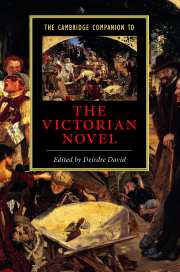Book contents
- Frontmatter
- Introduction
- 1 The Victorian novel and its readers
- 2 The business of Victorian publishing
- 3 The aesthetics of the Victorian novel: form, subjectivity, ideology
- 4 Industrial culture and the Victorian novel
- 5 Gender and the Victorian novel
- 6 Sexuality in the Victorian novel
- 7 Race and the Victorian novel
- 8 Detection in the Victorian novel
- 9 Sensation and the fantastic in the Victorian novel
- 10 Intellectual debate in the Victorian novel: religion, science, and the professional
- 11 Dickens, Melville, and a tale of two countries
- Guide to further reading
- Index
2 - The business of Victorian publishing
Published online by Cambridge University Press: 28 May 2006
- Frontmatter
- Introduction
- 1 The Victorian novel and its readers
- 2 The business of Victorian publishing
- 3 The aesthetics of the Victorian novel: form, subjectivity, ideology
- 4 Industrial culture and the Victorian novel
- 5 Gender and the Victorian novel
- 6 Sexuality in the Victorian novel
- 7 Race and the Victorian novel
- 8 Detection in the Victorian novel
- 9 Sensation and the fantastic in the Victorian novel
- 10 Intellectual debate in the Victorian novel: religion, science, and the professional
- 11 Dickens, Melville, and a tale of two countries
- Guide to further reading
- Index
Summary
For most of the eighteenth century the novel's physical form was highly variable: it might be published in one or two volumes, but it was equally likely to appear in three or more. Fanny Burney's Camilla (1796) was published in five volumes, Fielding's Tom ]ones (1749) in six, Richardson's Clarissa Harlowe (1748) in seven, and Sterne's Tristram Shandy in nine volumes spread over eight years (1760-67). By the early nineteenth century things had started to stabilize, and the standard number of volumes for a first edition of a novel had settled down to three or four. Each volume was usually priced at five shillings or six shillings so a three-volume novel would normally retail at between fifteen shillings and eighteen shillings.
The author who changed all that was Sir Walter Scott. Scott's influence on both poetry and prose in the early nineteenth century was immense. He may be little read now, but in his time and for a few decades afterwards his poems and novels were probably more widely distributed and consumed than the work of any other serious contemporary writer. At the height of the Romantic movement, many more people read Scott's poetry than Wordsworth's. In terms of copies printed and copies read, Coleridge, Keats, and Shelley were negligible. Only Byron was sometimes able to rival Scott in terms of numbers of readers. It was later, during the Victorian period, that Wordsworth and Coleridge, Keats and Shelley acquired their belated and relative popularity.
- Type
- Chapter
- Information
- The Cambridge Companion to the Victorian Novel , pp. 37 - 60Publisher: Cambridge University PressPrint publication year: 2000
- 7
- Cited by



